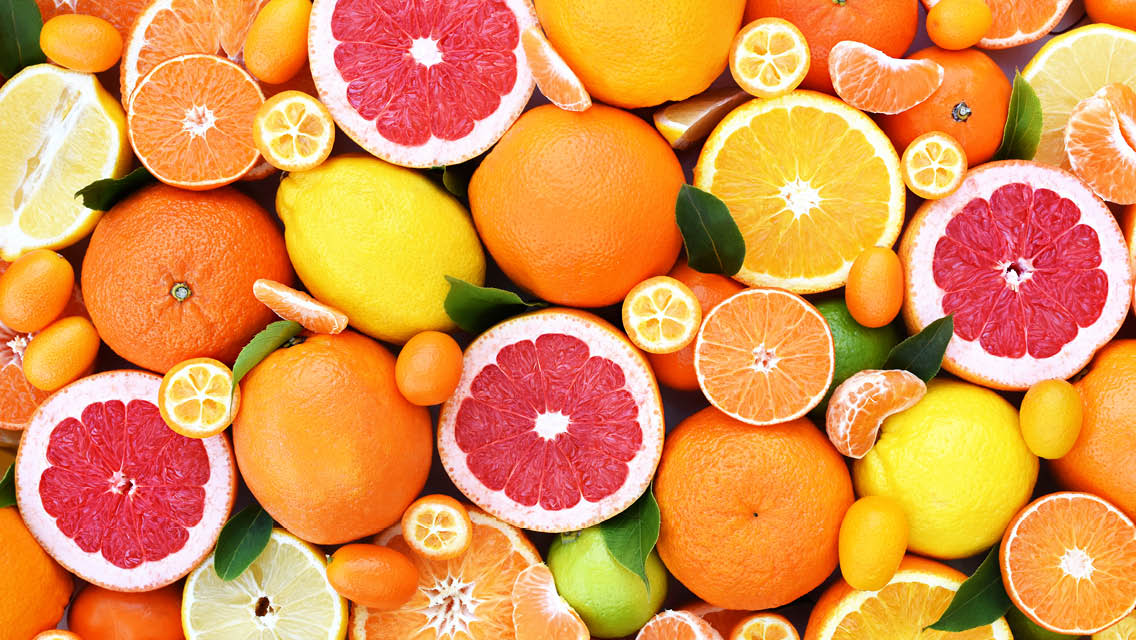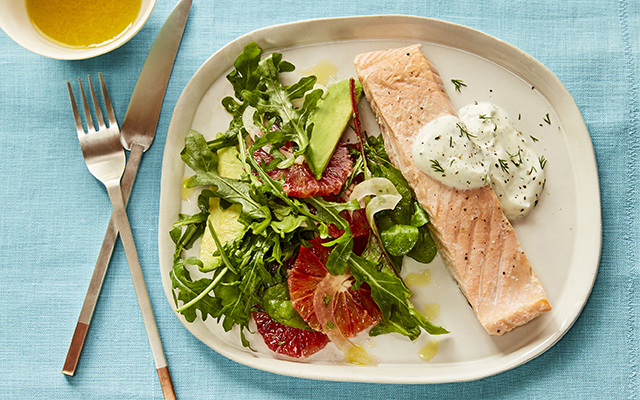Sections in this article:
Lemon • Lime • Orange • Grapefruit • The Necessity of Vitamin C
The zeal for low-carb eating has had some unfortunate side effects. Chief among them is the sidelining of fruits (and even some vegetables) for their sugar content, even though those foods have much to offer in terms of flavor and phytonutrients. Citrus fruits, which have been sustaining humans for centuries, deserve better than that.
Citrus plants are part of the rue family Rutaceae. Fossil records dating to the late Miocene period indicate that the ancestor of our modern citruses once grew along the subtropical slopes of Yunnan Province in China.
Sometime about 6 to 8 million years ago, a major shift in the climate not only began the spread of citrus fruits beyond Southeast Asia but also produced an explosion of new species. Still in existence and cultivated, the citrus fruits citron, pomelo, mandarin, and micrantha are the ancestors of nearly all of the tart-sweet, zesty spheres we enjoy today.
Citrus fruits are a fixture in recipes across almost every continent, thanks to the bright lift they bring to dishes and the essential nutrients they provide. With their low sugar levels, high fiber, and huge array of nutrients — including vitamin C, B vitamins, and minerals such as copper, phosphorus, magnesium, and potassium — citruses have earned a place on our plates. (Though perhaps not filling our glasses: Orange and grapefruit juices, with their high sugar content and lack of stabilizing fiber, are still best limited.)
One of the most important nutrients citrus fruits provide in abundance is vitamin C. “Vitamin C is an antioxidant that protects our cells against damage from free radicals, otherwise known as oxidative stress,” explains Cindi Lockhart, RDN, LD, IFNCP. “Oxidative stress is like cutting an apple and leaving it out — it browns; that’s what happens at our cellular level.”
Oxidative stress can trigger inflammation, which drives all chronic disease and dysfunction, she says. But vitamin C helps to neutralize it.
And that’s not all it does. “Vitamin C helps defend against viruses, bacteria, and pathogens,” Lockhart explains. “And it is necessary to make collagen, which we need to build and maintain healthy bones, joints, and skin.”
The body can’t make vitamin C on its own, so including more citrus in your diet is one easy way to ensure you’re getting adequate amounts of this key nutrient. (For more, see “The Necessity of Vitamin C” at the end of this article.)
Whether enjoyed as a handful of tiny tangerines for a snack or grapefruit sections in a salad, citrus also helps you meet your fiber needs and reap the benefits of dozens of antioxidants. There are nearly endless healthy ways to enjoy these nutrient-dense fruits — these are just a few of them.
Lemon
Nutrient content per lemon: Fiber: 2.35 g • Sugar: 2 g • Vitamin C: 44.5 mg
Lemon is one of the most versatile citrus fruits: The juice brightens up savory foods and balances sweet ones.
Lemons also have a long history in folk medicine. The traditional Italian remedy canarino (so named for its canary-yellow hue) is made by boiling lemon peels in hot water; it’s used as a digestive aid and cold remedy.
During the 18th and 19th centuries, lemons (and limes) were instrumental in keeping scurvy at bay for mariners at sea. With their sturdy peels, lemons could stay fresh onboard for weeks at a time.
While lemons are not particularly palatable eaten whole, the juice from one lemon offers about a quarter or more of the daily requirement for vitamin C. The fruit also contains abundant flavonoids that boast powerful antioxidant and anti-inflammatory effects, and the citrate in lemons may even help prevent the formation of kidney stones.
One thing to note: The acidity in lemon juice can wear down tooth enamel over time, so dilution is important.
Try this:
- “Squeeze fresh lemon into your water or herbal tea,” suggests Lockhart. A glass of water with lemon first thing in the morning may also help stimulate liver function.
- Mix up homemade lemonade with fresh lemon juice, water, and maple syrup.
- Make a cough-soothing toddy with hot water, lemon, ginger, and honey.
- Liven up marinades and salad dressings with the juice and the zest.
- Add lemon zest to vegetables before roasting.
- Spritz lemon over cooked vegetables or any dish that needs a little life.
- Tenderize meat — the acidity of lemon juice makes it a natural meat tenderizer.
Lime
Nutrient content per lime: Fiber: 1.9 g • Sugar: 1.1 g • Vitamin C: 29 mg
Although lemons are the standard citrus for European and Mediterranean cooking, lime is quintessential to South Asian, Southeast Asian, and Latin American cooking. The bright sour flavor and subtle sweetness complement the fragrant spices and herbs common in these cuisines. Lime’s popularity in these regions is likely due to the fact that the fruit thrives in tropical climates.
Limes are both sweeter and more acidic than lemons. Persian limes and Key (Mexican) limes are the most widely grown worldwide; makrut limes are the next most common.
Flavonoids like quercetin, kaempferol, and tangeretin are all found in the juice, peel, and pulp of limes. Like other citrus fruits, they also contain hesperidin, an antioxidant with neuroprotective properties.
All these phytonutrients are antioxidants, which means limes can help support your immune system and safeguard against inflammatory disease.
One important tidbit to keep in mind the next time you’re squeezing limes: The compound furanocoumarin can cause phytophotodermatitis (a.k.a. “margarita burn”) if you go out into the sun with lime juice on your skin. Take care to wash your hands if you get any juice on your skin, especially if you’re heading outdoors.
Try this:
- Spritz lime juice over home-made curries garnished with cilantro or lemongrass; the citrusy flavors in these herbs perfectly complement lime.
- Add lime to guacamole or avocado salad to cut through the avocado’s creaminess and help prevent browning.
- Season black beans with cumin and garlic and toss with juice and zest.
- Squirt lime on Caribbean meals, such as stewed or jerk fish, or on other seafood.
- Dollop a spoonful or so of Indian lime pickle (nimbu ka achar) over biryani or pulao to add a spicy, tangy, complex layer of flavor.
- Keep things simple with homemade limeade.
Orange
Nutrient content per orange: Fiber: 2.8 g • Sugar: 12 g • Vitamin C: 83 mg
The word “orange” has passed down to us from n-ara•ngah, the Sanskrit word for “orange tree.” Experts believe sweet oranges first appeared in the humid Indian forests that run along the foothills of the Himalayas or perhaps farther east in China. It’s no surprise so many orange varieties come from these regions.
Today’s oranges are a hybrid originally created by crossing pomelo with mandarin, and there are a lot of orange varieties out there. Tangerines, clementines, satsumas, blood oranges, Cara Cara, and Valencia are readily available in supermarkets. Pure mandarins are one of the original citrus fruits; they’re the progenitor of oranges, not a subtype.
Carotenoids give the fruit their orange color, while the sanguine hue of blood oranges comes from anthocyanins, the same phenolic compounds that give red grapes, pomegranates, and red cabbage their concentrated hues and offer anti-cancer, anti-inflammatory, and antidiabetic health benefits.
Just one large navel orange satisfies more than 90 percent of your daily vitamin C needs. In fact, the benefits of eating oranges significantly outweigh those of drinking the juice. One 8-ounce glass of OJ contains about 16 grams of sugar (an -orange has 12), and none of the fiber.
Although oranges have more sugars compared with other citrus, their fiber and low glycemic-index count help prevent blood-sugar spikes. So does combining oranges with other foods or eating them for dessert.
“Having [citrus] as part of a meal reduces the risk [of blood-sugar spikes], and so having protein and fat prior to the citrus would also reduce the risk,” says functional-medicine physician Terry Wahls, MD, author of The Wahls Protocol.
Try this:
- Chop oranges into homemade salsa with other citrus and onions.
- Enjoy them in leafy-green salads or hearty whole-grain bowls, where the combined fiber will help control blood-sugar levels.
- Use the juice to make glazes and marinades for meats and root vegetables (such as sweet potatoes) rather than drinking it.
- Save those peels! Use them to infuse olive oil; dry them and use for teas; add them to soups, stews, or stocks; or mix them into marinades. Dried orange peels add a lovely bitterness that rounds out a variety of dishes.
Grapefruit
Nutrient content per grapefruit: Fiber: 2.8 g • Sugar: 17.9 g • Vitamin C: 88 mg
Ranging across a spectrum from yellowish-white to the palest of pinks to rich salmon reds, grapefruits are a hybrid that appeared on the scene relatively recently, sometime around the 17th or 18th century, in Barbados. Although most orange subtypes are the product of deliberate crossing, the grapefruit is likely a wild crossing, a happy accident of nature and the haphazard planting of citrus trees in the West Indies.
Sweet, tart, and a little bitter, grapefruits are refreshing on their own, and they liven up a range of dishes. Red and pink varieties contain carotenoids including beta-carotene, lycopene, lutein, and zeaxanthin. These not only give the fruits their intense color but also support eye health and protect the body from free radicals.
Along with certain orange cultivars like Seville oranges and pomelos, grapefruits contain furanocoumarins. But beware: In grapefruits, concentrations are high enough to disrupt the function of certain drugs. If you’ve ever seen the words “Do not take with grapefruit” on a medication label, this is because of furanocoumarins.
“Furanocoumarins block an enzyme produced by the liver and intestines to break down certain medications in the body,” Lockhart explains. “This results in the body absorbing more medication than it should,” which increases the risk of overdose and adverse side effects.
That’s really the only situation in which grapefruit is best avoided. The myriad benefits of these nutrient-dense fruits can be enjoyed several ways.
Try this:
- Slice in half crosswise, segment, and scoop out with a spoon, or peel, separate into segments, and eat it as you would an orange.
- Roast grapefruit to caramelize the sugars and highlight the fruit’s sweetness.
- Add grapefruit to salads with avocado; they’ll complement the avocado’s creaminess.
- Include grapefruit in quinoa bowls or your morning oatmeal — the extra fiber may help moderate your insulin response to the grains.
- Add grapefruit to Greek yogurt, chia-seed pudding, or homemade granola for a hearty breakfast.
- Save and dry those peels! A little grapefruit peel adds a citrusy pop to virtually any dish.
The Necessity of Vitamin C
Vitamins A and D are fat soluble and can be stored in our bodies until they’re needed. Vitamin C is water soluble, and so we require a daily dose in our diets to stay healthy.
Present in everything from citrus to bell peppers, kiwis, and strawberries, vitamin C plays a critical role in the health of blood vessels, muscles, bones, cartilage, and collagen. In this latter capacity, vitamin C — consumed or applied topically — helps with wound healing and overall skin health.
Also known as ascorbic acid, this antioxidant helps boost the immune system and reduce oxidative stress, thanks to its anti-inflammatory properties.
The recommended daily amount of vitamin C is 75 mg for women, 85 mg for pregnant women, and 120 mg for women who are breastfeeding; men should aim to get about 90 mg per day.
This article originally appeared as “Celebrate Citrus” in the January/February 2023 issue of Experience Life.





This Post Has One Comment
Very informative,well laid out. I was able to understand the information with out a moment of boredom!
Thank you